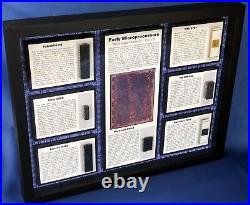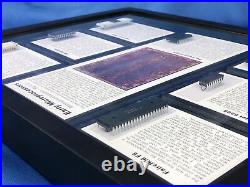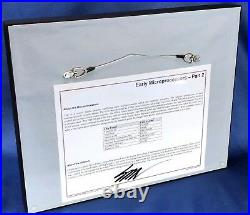Early Microprocessors Part 2 PPS-4, F8, Intel 8008, 6100, 6701, IMP-00A, 2650




This collection contains some of the earliest, and perhaps more esoteric, microprocessors. These designs are among the very first microprocessors, but when compared with the Intel 4004, MOS 6502, or Zilog Z80, they are relatively obscure. Many of these were the first microprocessors for their respective companies and, in fact, played important roles in the development of the microprocessor industry. The design variation of these devices is amazing. All developed in the 1970's, some were 4-bit, others 8-bit, one even 12-bit. They used TTL, PMOS, NMOS, and CMOS technologies. Whether the job was to run mini-computer software or control a pinball machine, early microprocessor designers were free to decide what their microprocessor would look like and act like. They could focus on its function. The internal architecture of these microprocessors is quite varied. The 6100 was designed as a DEC mini-computer on a chip. The 8-bit F8 and 2650 were good at realtime control and powered early video consoles. The PPS-4 is best known for powering Gottlieb pinball machines. The Intel 8008 was the first 8-bit microprocessor. The IMP-00 and 6700 were both bit-slice designs. The PPS-4, 6700, and IMP-00 were 4-bit devices, while the 6100 was a 12-bit device.
Some of these favored more registers, others fewer. Some had stack implementations, others didnt.
With no preset notion of what a microprocessor should be, designers let the function guide the design. Here are the microprocessors included in this piece. The background image of the artwork is of the Rockwell PPS-4 microprocessor. The microprocessors in this display are the Rockwell PPS-4 (11660EC), Fairchild F8 (F3850PC), Intel 8008 (D8008), Intersil 6100 (IM6100AIPL), Monolithic Memories 6700 (6701D), National Semiconductor IMP-00A (IMP-00A/520J), and the Signetics (2650AI). The artwork is framed in an 11"x14" black shadow box frame, with glass. All framing materials are acid free. A narrative about the artwork that includes the artists signature is placed on the back of the artwork.Limited by availability of chips. Just add all your items to the cart, and then checkout.
Want to see more ChipScapes? Also please check out my ChipScapes.
Computer chips start out as ordinary sand, which is silicon dioxide. However, the silicon must be made very, very pure. The first step is to melt the sand, in a furnace that reaches about 3200.
F, and mix with carbon. This first purification process creates 99% pure Silicon, a common output is Silicon Carbide. The Silicon Carbide is processed in a trichlorosilane distillation method to create 99.9999% pure silicon called polycrystalline silicon.
The polysilicon is broken up into chunks. These chunks are melted in a crucible at about 2500. A silicon crystal seed is dipped in molten silicon and slowly drawn out to create a cylinder of silicon.
These silicon cylinders are some of the purest crystals on the planet. Once the silicon cylinder is grown to the desired diameter, it is sawed into wafers. These wafers are polished to achieve a very flat mirror surface. Transistors, and other micro-electronic parts, are built on the polished wafer in layers in a process called etching.The wafer is then sawed into its individual chips. Each chip is mounted in an electronic package that serves to protect it and connect it to the outside world. It has been said that computer chips are the greatest value added product in the world.
We essentially take a pile of sand and change it into thousands of dollars worth of computer chips. These artworks are the creation of.
Are photographs taken of computer chips, boards, and other computer artifacts. They are sort of chip landscapes, or.Most often a macro-lens or microscope is used with special lightning to achieve these unique artworks. Intel, IBM, Fairchild, DEC, Signetics, Intersil, AMD, Zilog, Motorola, MOS, NEC, Texas Instruments, are some of the great chip making companies. Chips like the Intel 4004, MOS 6502, Zilog Z80, AMD 2901, IBM PowerPC and others have changed the way people work and play.
Are dedicated to preserving and sharing these computing and communication technologies that changed the world. Artworks are fine collectible artworks. Come is a variety of shapes sizes and colors. Clusters of my artwork make for stunning displays!
Would make a great gift for the nerd, geek, engineer, programmer, IT executive, or just that technology savvy person in your life. For more information about ChipScapes. Please check out my ChipScapes. For more information about chip collecting as a hobby. The item "Early Microprocessors Part 2 PPS-4, F8, Intel 8008, 6100, 6701, IMP-00A, 2650" is in sale since Thursday, September 20, 2018.
This item is in the category "Art\Mixed Media Art & Collage Art". The seller is "chipscapes" and is located in Winter Park, Florida. This item can be shipped worldwide.
- Original/Reproduction: Limited Edition
- Size: Small (Up to 14in.)
- Materials: Paper, Silicon, Metal
- Style: Impressionist
- Type: Collage
- Subject: Computer Chips
